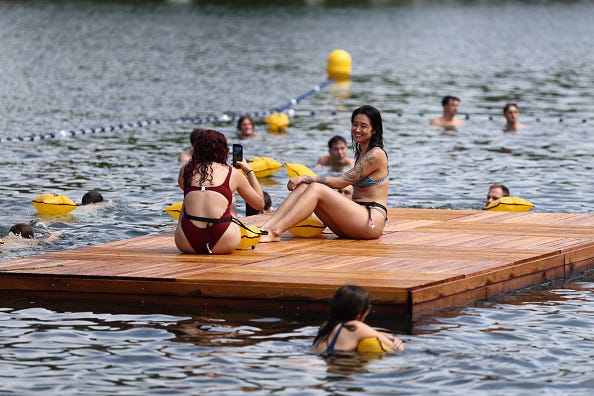A New Era for the Seine: Swimming in Paris After a Century
For the first time in over 100 years, the Seine River in Paris has become a place for swimming and recreation. This transformation is the result of a $1.5 billion cleanup project that was significantly accelerated by last year’s Olympic Games. The river, once a central part of daily life in Paris, had been banned for swimming since 1923 due to severe pollution. Now, it’s making a remarkable comeback.
Catherine Porter of The New York Times recently shared her experience of swimming in the Seine. She described diving into the river near Île Saint-Louis, surrounded by historic buildings and iconic bridges. “A crowd splashed around me, giggling with pleasure and wonder,” she wrote. Her account highlights the joy and excitement of Parisians rediscovering their river.
The International Olympic Committee (IOC) notes that swimming was once a common activity in Paris. However, pollution led to its prohibition. Efforts to clean up the Seine began in the 1990s, with the Greater Paris Sanitation Authority setting a goal to make the river swimmable again. These efforts gained momentum with the Olympics, which played a key role in pushing the project forward.
Paris Mayor Anne Hidalgo emphasized the impact of the Games on the city. “The spirit of the Games continues to live on in the streets of Paris. And now, in the waters of the Seine,” she said. She credited the Olympic and Paralympic Games for accelerating progress, enabling the city to meet environmental and health challenges.
During the Olympics, the Seine served as a backdrop for the Opening Ceremony and hosted several competitions. Despite concerns about water quality, athletes reportedly used Coca-Cola to flush out potential toxins. This unusual method underscored the need for effective pollution control.
To address decades of contamination, a massive underground storage basin near Austerlitz was constructed. It can hold the equivalent of 20 Olympic-sized swimming pools of wastewater, preventing untreated water from entering the river during heavy rains.
Now, the Seine offers three natural swimming sites: Bras Marie, Bercy, and Grenelle. These areas officially opened to the public earlier this month, allowing around 1,000 swimmers per day through the end of August. Kayaking is also available at Grenelle. The sites feature removable, modular structures designed to blend with the urban landscape and provide cooling spaces as temperatures rise.
Lifeguards are stationed along the river to ensure safety. Paris Mayor Anne Hidalgo, who called swimming in the Seine a “childhood dream,” expressed her delight at the river’s revival. Others, like Fabrice Atallah, have described the experience of swimming while seeing the Eiffel Tower as “amazing.”
Martine Laupin, 76, shared her joy after taking a dip in the Seine. “What a joy. What a joy,” she said. “This is Paris. Imagine!”
The cleanup project has broader implications beyond Paris. The IOC highlighted how the Olympics can drive infrastructure improvements in host cities. Future Olympic hosts, including Milan and Cortina d’Ampezzo, Los Angeles, the French Alps, Brisbane, and Salt Lake City, may benefit from similar investments.
The Seine’s transformation is a testament to what can be achieved through dedicated efforts and international collaboration. As Parisians enjoy the river once more, it serves as a symbol of renewal and hope for the future.







